Start Total Christian Certification Course FREE Now!
They’re the giants of the web, one dominating search, the other king of the online shop. But when it comes to the race to rule the smart speaker space, the Amazon Echo and Google Home are pretty evenly matched.
The voice controlled audio devices promise to take the strain off your everyday life – need to set a time? Just ask the Google Assistant. Want to play your favorite spring cleaning playlist without lifting a finger? Your wish is Amazon Alexa’s command. Both voice-activated digital butlers can carry out thousands of tasks, many similar, but with some key differences between the two product ranges that you’d be wise to be aware of.
So, it’s the future of speakers – but which is for you? Amazon Echo, or Google Home? And, which specific model suits your needs? We put them head-to-head.
Amazon Echo: the different models compared
Let’s kick off with the smart speaker that started it all – the Amazon Echo. Its vanilla version is likely where you’ll want to begin – it stands 14.8cm tall and sounds pretty damn good for its price, supporting Bluetooth and Wi-Fi connections, with the signature blue-ring around its top that tells you when it’s listening after hearing its default wake word, “Alexa”.
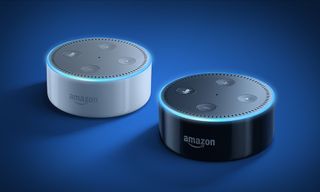
The Amazon Echo Dot
Perhaps the most popular Echo of all though is the Echo Dot – it’s the cheapest of the entire bunch and is about the same size as a hockey puck. Its size means its speaker is quite tinny and weak, so it’s better suited for rooms where music playback won’t be its primary function – but you can pair it up with a Bluetooth speaker or another audio device using an AUX jack connection, which makes it perhaps the most cost-effective upgrade you could make to an aging Hi-Fi system.
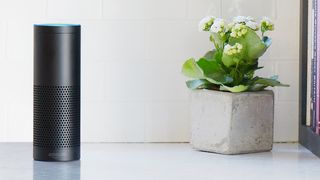
Amazon’s Echo Plus
The Echo Plus has a more industrial look, standing taller than the vanilla Echo with exposed speaker grilling, and it doubles up as a smart home hub for connected devices, too, justifying its extra premium in price.
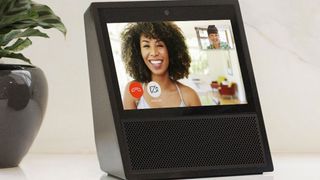
The Amazon Echo Show
The Spot and the Show are the two Amazon Echo devices to feature a screen. You can think of the Echo Spot as an upgraded Echo Dot – perfect for a bedside table, with the ability to make video calls through its circular screen. The Echo Show is essentially an Amazon Fire tablet with an Alexa speaker strapped to the bottom, letting you ask about shows available on Amazon’s services and partner apps (including the likes of BBC News), making it like a second screen for your kitchen.
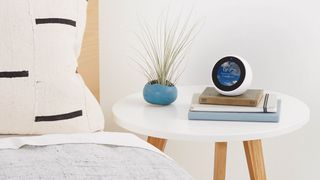
Amazon’s Echo Spot
All have access to the majority of Alexa skills (think voice controlled apps) available, though only the Plus can double up as a bridge for your smart home devices – while all Echo products can talk to things like smart bulbs and thermostats, it’s only the Plus that lets you do away with individual hubs for each additional gadget family.
The boxy Echo Show aside, all Echo products are attractive – particularly the new-look fabric-covered standard Echo, and the Magic Eight Ball-like Echo Spot. Unobtrusive, they’re slightly more industrial looking than Google’s speaker option, but arguably smarter looking, too.
Google Home: each model compared
Google’s smart speaker range is a touch smaller than Amazon’s, with just the three Google Home speakers to choose from. At this stage, none feature screens either (though these are in the works, both in house and with third-party manufacturers looking to work with Google Assistant), so it’s a pure audio experience with Google at this time.
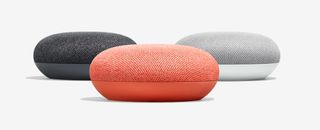
The Google Home Mini
The smallest of the three is the Google Home Mini speaker. It, like the Echo Dot, is puck shaped (if a little more pebble-like with its softer edges), with its top side covered in a fabric speaker mesh. It’s available in a range of colors, with four flashing LED lights used to illustrate when it’s listening to your commands.
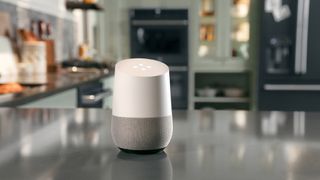
The Google Home
At the middle of the range is the standard Google Home, which looks considerably different. It looks a little like a small vase, with a two-tone color design (again with multiple options to choose from) and a sloping top side that houses a touch control panel.
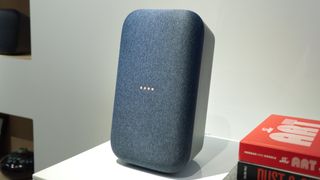
The Google Home Max
The Google Home Max looks much more like a traditional loudspeaker, and is the largest of the bunch. It’s boxy in design, and closer aesthetically to the Google Home Mini with its mesh speaker covering. It can stand in either a portrait or landscape orientation to suit the needs of your decor.
While the vanilla Google Home is an acquired taste in terms of design, both the Mini and Max are subtly attractive, and should fit into any surroundings without much concern.
Keep in mind that, with both Alexa and Google Assistant, third-party speaker manufacturers are increasingly choosing to integrate the voice helpers into their products. So if there’s an audio manufacturer that you’re particularly fond of, it may be worth holding out to see if they’ve any plans to join either of the smart ecosystems – at this point, it’s highly likely that most all audio devices in the near future will come equipped with some sort of microphone and voice control system.
Smart features
Both Google and Amazon are committed, long term, to improving their respective voice platforms, and each has done a good job so far of enticing third-party smart device manufacturers – from thermostat makers to smart lighting companies – to make their products compatible with each service. With a base level of commands available to each, with either a “Hey Google”, or “Alexa…” wake word uttered, control of the digital world is just a vibration of your vocal chords away.
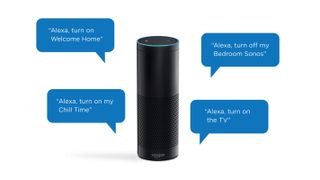
But the two take a slightly different approach to the way their abilities are accessed. Google Home’s abilities are, by default, accessible to all – barring pairing up third-party smart home devices with your Google Home system, if you’ve made a request that the Google ecosystem can understand, it’ll carry out the required response unprompted. Alexa, on the other hand, relies on the installation of Skills – individual, app-like sets of related voice commands focussing on certain topics or abilities. Handled and activated through the Alexa app on smartphones, these can range from getting information on local transport times, or even to activating voice-controlled games.
There’s no right or wrong approach – Google’s is simpler, while Alexa’s encourages faster and broader development and support from third-parties.
Audio
As you’d expect from such a wildly varying range of shapes and sizes, you get very different sound performance across both ecosystems, let alone when comparing competing models. Here’s a general breakdown of how they sound in relation to each other:
If you can only afford the entry-level devices, and music remains a top priority for you. Go for the Google Home Mini, which sounds a lot better than the Echo Dot. Unless you hook up a Dot to another speaker over Bluetooth or the 3.5mm jack, it’s just too thin and harsh to fully enjoy.
If you’re looking for a small Echo speaker, your best best then is the Echo Spot, which despite its size offers a richer sound. The screen, however, massively increases its expense.
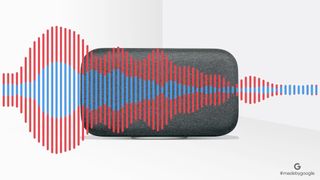
When you’re moving up the size scale, Google’s Home is too bass-heavy to be truly enjoyable. It also has worse clarity than the latest generation of Echo speaker and Echo Plus. So if you’re limited to around $100/£100, the Amazon Echo may be the best choice.
With a slight premium in price, and the inclusion of Dolby processing, the Echo Plus sound is more dynamic than the standard Echo, as you’d hope.
And, despite its looks, the Echo Show sounds better than the Echo Plus and Echo, though not so dramatically as to forgive it some of its other failings.
If you’re going for pure sonic superiority between the Echo and Google Home ranges however, opt for the Google Max. Its bass is well tuned, its mids and highs well defined, and its top volume levels loud without verging into highly distorted territory.
Verdict
The choice really then comes down to the preference of ecosystem as opposed to the hardware. Are you heavily invested in Google’s services? Then Google Home is probably for you, as the two areas are only going to become ever-more-closely linked. Google’s natural language understanding is superior too, even if its voice implementation still needs some refinement.
However, in terms of sheer value for money and the already vast reach of its collaborations and abilities, Amazon’s Alexa devices seem the more sensible bet at this stage. It’s a close run race, with Google’s powerful search capabilities potentially seeing it through in the long run. But there’s something to be said for Amazon’s more focussed approach – from our experience so far, Alexa currently feels like the more reliable assistant. But that could change. Either way, place your bets – you’re unlikely to come away disappointed.















